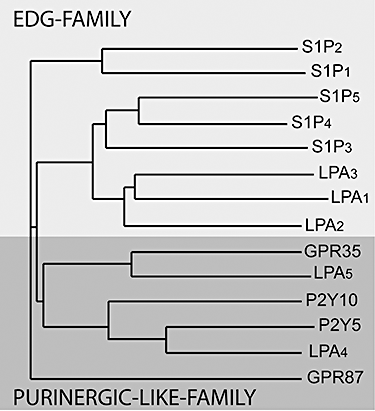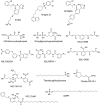Aiming drug discovery at lysophosphatidic acid targets
- PMID: 20735414
- PMCID: PMC2989581
- DOI: 10.1111/j.1476-5381.2010.00815.x
Aiming drug discovery at lysophosphatidic acid targets
Abstract
Lysophosphatidic acid (LPA, 1-radyl-2-hydroxy-sn-glycero-3-phosphate) is the prototype member of a family of lipid mediators and second messengers. LPA and its naturally occurring analogues interact with G protein-coupled receptors on the cell surface and a nuclear hormone receptor within the cell. In addition, there are several enzymes that utilize LPA as a substrate or generate it as a product and are under its regulatory control. LPA is present in biological fluids, and attempts have been made to link changes in its concentration and molecular composition to specific disease conditions. Through their many targets, members of the LPA family regulate cell survival, apoptosis, motility, shape, differentiation, gene transcription, malignant transformation and more. The present review depicts arbitrary aspects of the physiological and pathophysiological actions of LPA and attempts to link them with select targets. Many of us are now convinced that therapies targeting LPA biosynthesis and signalling are feasible for the treatment of devastating human diseases such as cancer, fibrosis and degenerative conditions. However, successful targeting of the pathways associated with this pleiotropic lipid will depend on the future development of as yet undeveloped pharmacons.
Figures






References
-
- Ahn DK, Lee SY, Han SR, Ju JS, Yang GY, Lee MK, et al. Intratrigeminal ganglionic injection of LPA causes neuropathic pain-like behavior and demyelination in rats. Pain. 2009;146:114–120. - PubMed
-
- Alexander JS, Patton WF, Christman BW, Cuiper LL, Haselton FR. Platelet-derived lysophosphatidic acid decreases endothelial permeability in vitro. Am J Physiol. 1998;274(1 Pt 2):H115–H122. - PubMed
-
- Amisten S, Braun OO, Bengtsson A, Erlinge D. Gene expression profiling for the identification of G-protein coupled receptors in human platelets. Thromb Res. 2008;122:47–57. - PubMed
-
- Angeli V, Llodra J, Rong JX, Satoh K, Ishii S, Shimizu T, et al. Dyslipidemia associated with atherosclerotic disease systemically alters dendritic cell mobilization. Immunity. 2004;21:561–574. - PubMed
-
- Aoki J, Inoue A, Makide K, Saiki N, Arai H. Structure and function of extracellular phospholipase A1 belonging to the pancreatic lipase gene family. Biochimie. 2007;89:197–204. - PubMed
Publication types
MeSH terms
Substances
Grants and funding
LinkOut - more resources
Full Text Sources
Other Literature Sources
Miscellaneous

